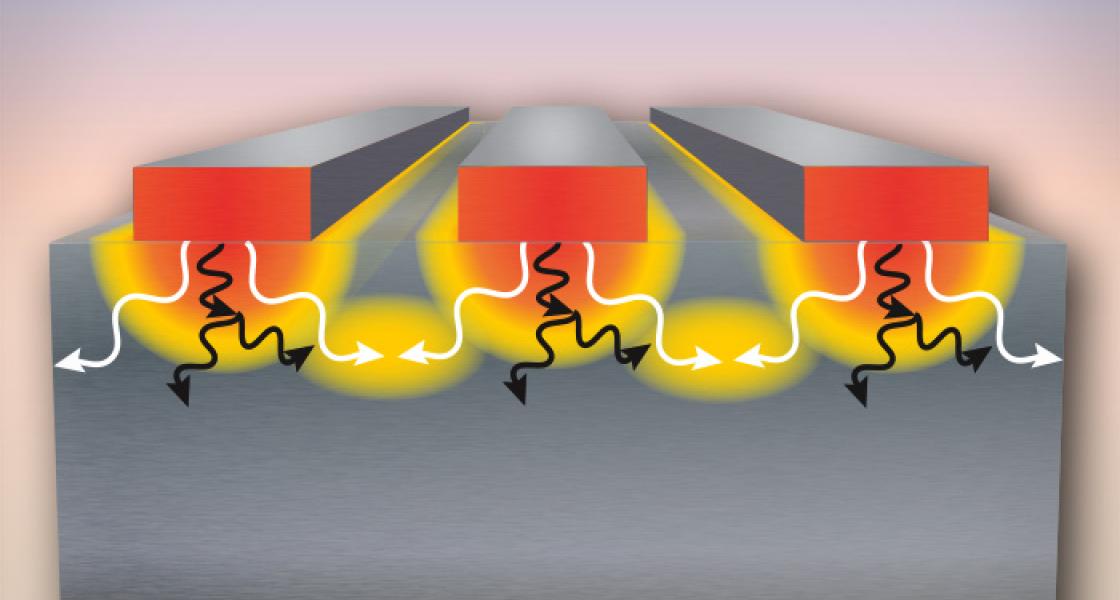One of the great challenges in the semiconductor and electronics industries is that as nanoscale features get smaller and processes get faster, enormous amounts of heat need to be quickly carried away from the nanostructures. The Kapteyn/Murnane group has made the counter-intuitive discovery that it is easier to cool these nanostructures when they are arranged closely together. The researchers also developed a theory to explain this unexpected new behavior.
In their experiments, the group measured the cooling rate of a collection of tiny hot metal nanowires embedded on substrates like silicon, sapphire, or other materials. When the nanostructures were heated with an infrared laser, they emitted phonons (lattice vibrations), which traveled into the substrate and collided with other phonons, carrying away the heat.
When the nanostructures were close together, there were more heat-dissipating collisions because phonons traveled shorter distances before colliding with another phonon. It made no difference to the cooling process whether the colliding phonons came from the same hot nanostructure or neighboring hot nanostructures. Thus, paradoxically, arranging the hot nanostructures more closely together actually enhanced heat dissipation.
This result is exciting news for the field of nanoelectronics because in 2010 the Kapteyn/Murnane group showed that small, isolated hotspots are, in fact, quite challenging to cool.
What’s interesting is that the nanowire size and spacing where these effects were seen is slightly different in silicon, sapphire, and other substrate materials. That’s because the distance each phonon travels before colliding with another phonon is a distinctive feature of a particular substrate.
When they first observed this unexpected behavior, the researchers had to come up with a new theory to explain what was happening. They used the new theory to predict that nanowire heat sources would cool more rapidly when placed next to other heat sources than when they were isolated. Finally, they verified their new theory experimentally. In the process, they learned all kinds of interesting things about materials such as (1) exactly which vibrations carry heat away from a hot region and (2) new ways to engineer the cooling rate in a material.
The researchers include graduate students Kathy Hoogeboom-Pot, Jorge N. Hernandez-Charpak, and Travis Frazier, senior research associate Damiano Nardi, Fellows Margaret Murnane and Henry Kapteyn, as well as colleagues from CU’s Department of Mechanical Engineering and the Lawrence Berkeley National Laboratory (Berkeley Lab). Their work was published online on March 23, 2015, in the Proceedings of the National Academy of Sciences USA.
This work is expected to have a significant impact on the semiconductor and electronics industries where heat dissipation in nanostructures is a huge issue as industrial designers attempt to encapsulate more and more information into smaller and smaller spaces. It can be immediately applied to the design of integrated circuits, thermoelectric devices, heat therapies mediated via nanoparticles, and nanoenhanced solar cells used in clean energy technologies.



 The Physics Frontiers Centers (PFC) program supports university-based centers and institutes where the collective efforts of a larger group of individuals can enable transformational advances in the most promising research areas. The program is designed to foster major breakthroughs at the intellectual frontiers of physics by providing needed resources such as combinations of talents, skills, disciplines, and/or specialized infrastructure, not usually available to individual investigators or small groups, in an environment in which the collective efforts of the larger group can be shown to be seminal to promoting significant progress in the science and the education of students. PFCs also include creative, substantive activities aimed at enhancing education, broadening participation of traditionally underrepresented groups, and outreach to the scientific community and general public.
The Physics Frontiers Centers (PFC) program supports university-based centers and institutes where the collective efforts of a larger group of individuals can enable transformational advances in the most promising research areas. The program is designed to foster major breakthroughs at the intellectual frontiers of physics by providing needed resources such as combinations of talents, skills, disciplines, and/or specialized infrastructure, not usually available to individual investigators or small groups, in an environment in which the collective efforts of the larger group can be shown to be seminal to promoting significant progress in the science and the education of students. PFCs also include creative, substantive activities aimed at enhancing education, broadening participation of traditionally underrepresented groups, and outreach to the scientific community and general public.